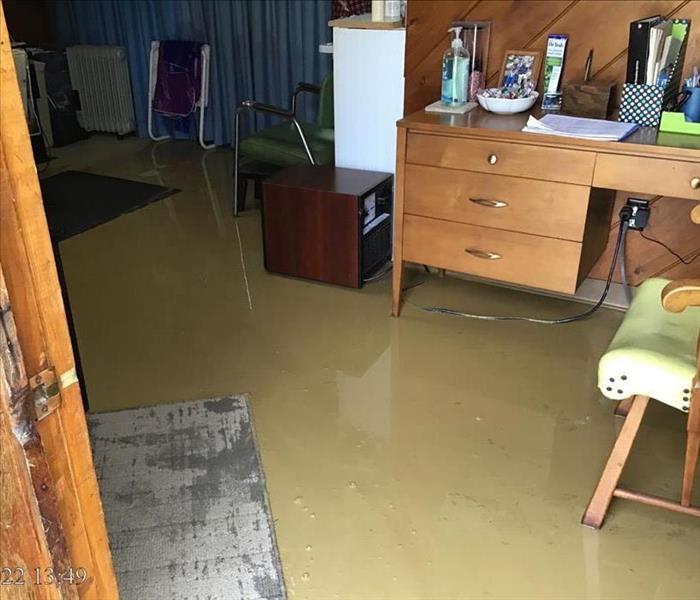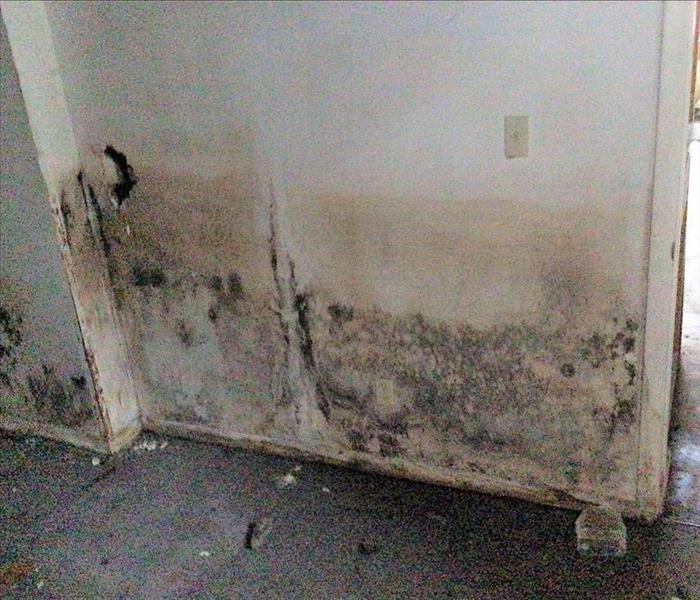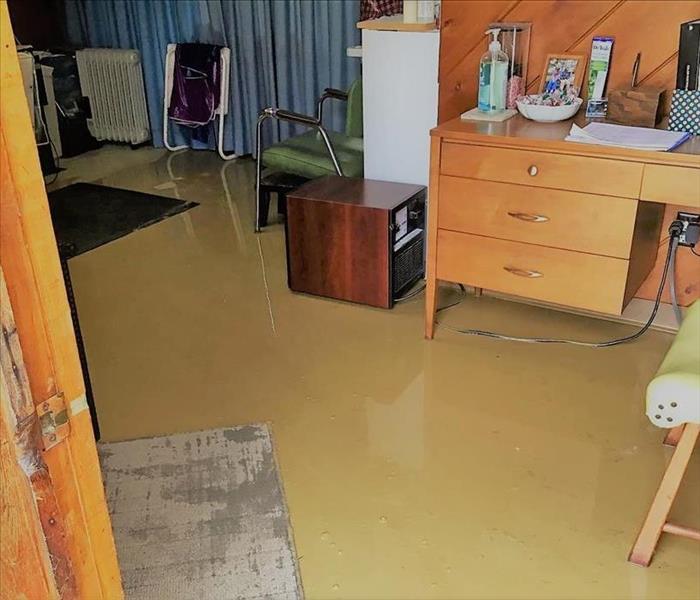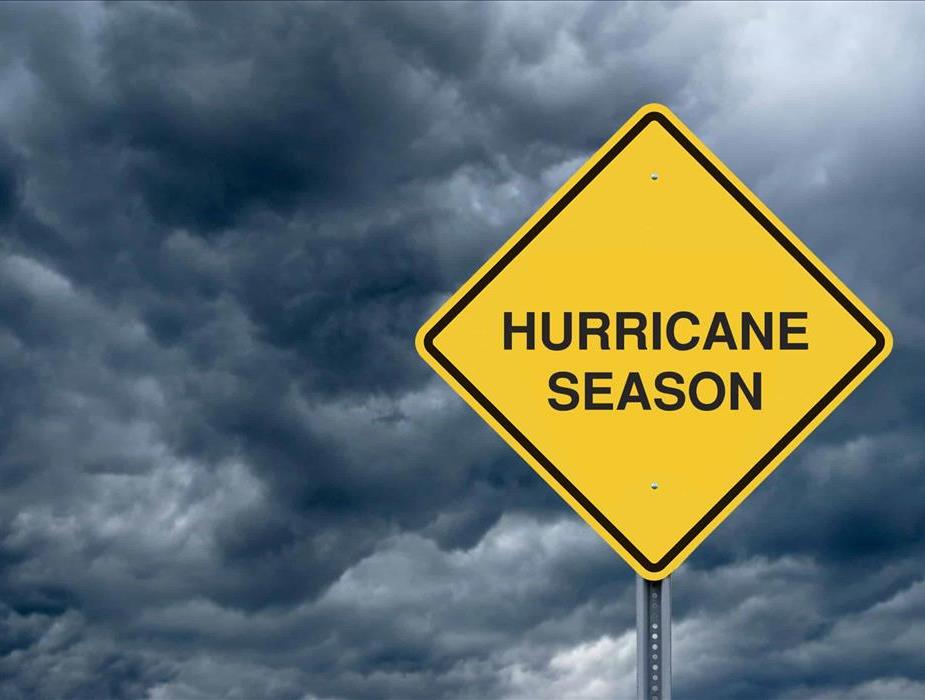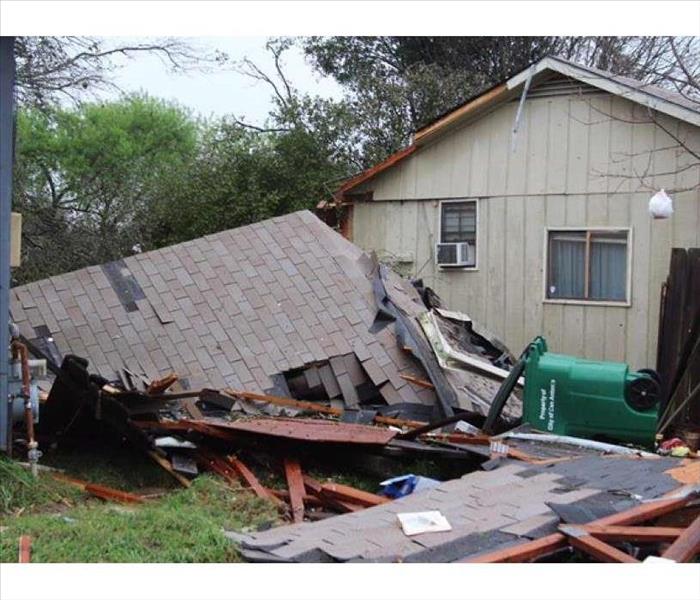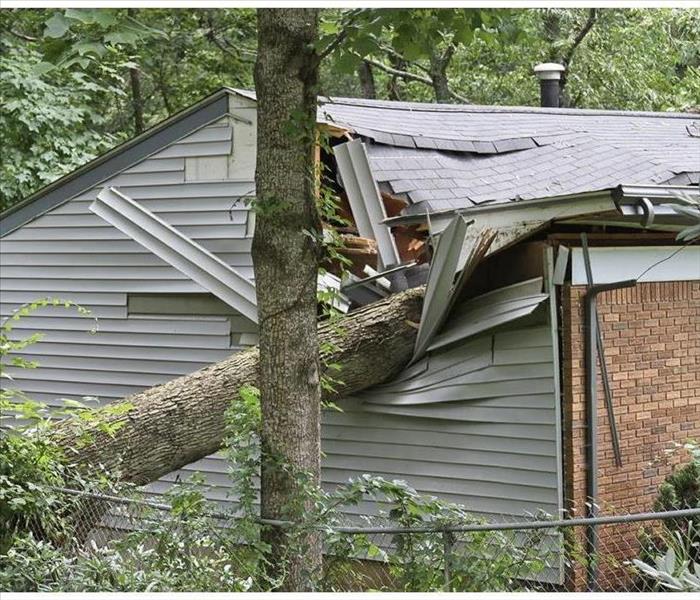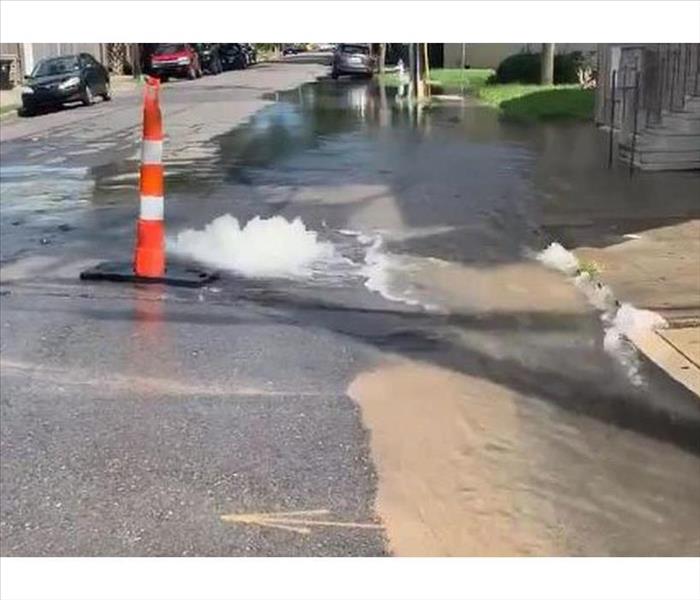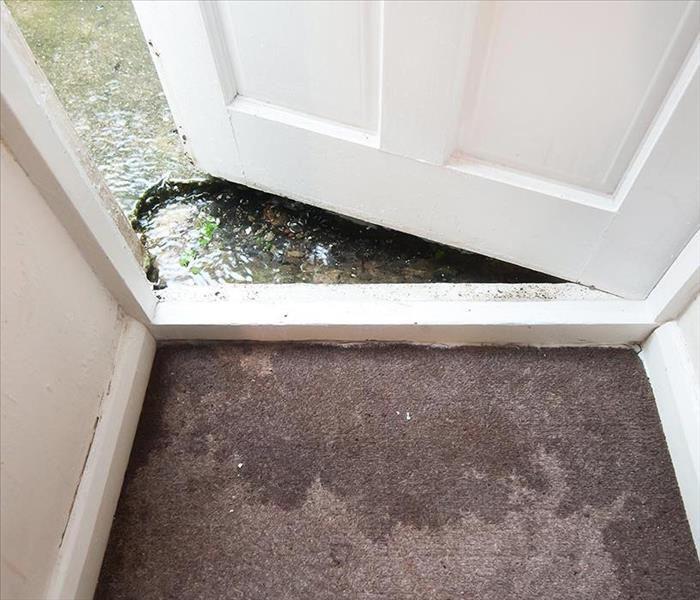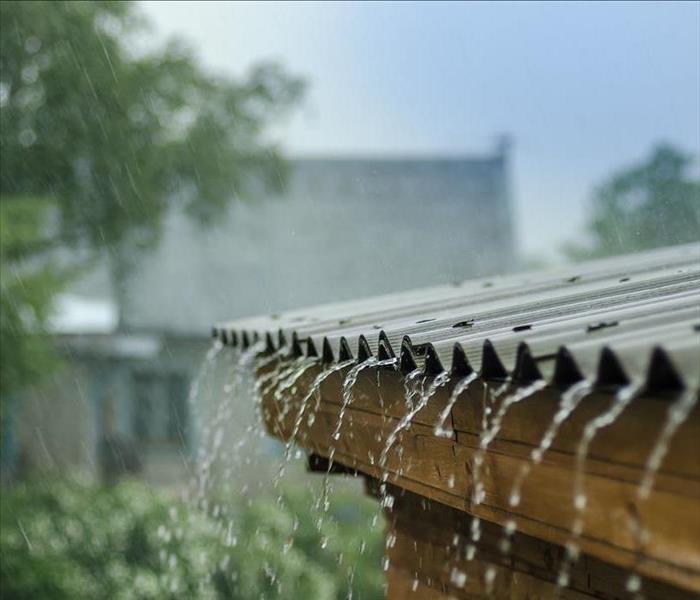Archived Storm Damage Blog Posts
Why the Cause of a Flood Matters
7/25/2022 (Permalink)
Flood damage and storm damage both can result in serious problems for your business. Although storms can cause flooding, the two are considered separate categories for insurance purposes. It is important to know the difference so that you can make sure you have the right insurance coverage for your business before a disaster occurs.
Floods
Flooding is generally defined as water damage that occurs over at least two acres or that affects two or more separate properties. Floods are caused by many natural phenomena, including the following:
- Surface water buildup
- Tidal or inland water overflow
- Erosion near bodies of water
- Mudflow
Even when the above instances are caused by a storm, most insurance companies consider them to be flood damage rather than storm damage and will not cover the damage if you do not have a separate flood policy.
Storms
If a storm damages your business with hail or wind and that results in water damage, many insurance companies would consider that to be storm damage because the initial event was separate from the water damage. In other words, the initial event occurred before and resulted in the water damage. Tornadoes, hurricanes, typhoons, and other types of storms can all cause this sort of damage. Some insurance companies have a separate deductible for hurricanes and other tropical storms, so make sure you are familiar with the specifics of your policy.
Other Causes
Sometimes flooding is not caused by Mother Nature. Problems with appliances and plumbing can also cause your property to flood. Most of these situations generally would be covered by your property insurance, but always make sure you know the details of your policy before an emergency occurs.
Regardless of the causes of flood damage to your business, a professional restoration service can help you get your business back in pre-flood condition quickly and safely.
How to Prevent Mold After a Flood
5/27/2022 (Permalink)
A flood in your home or business creates nothing short of panic. It will get you running for the mop, towels, and wet/dry vacuum. Now that the standing water is under control, you will need to focus on mold prevention. Mold growth is an issue that needs to be addressed within 48 hours. Here are four ways to prevent mold after a flood.
- Remove Standing Water
A wet/dry vacuum can be your best friend. Safely removing water quickly is best to minimize potential damage. If you don’t already own one, it would be a wise investment.
- Remove Carpet
It’s very hard to dry carpet completely because the padding underneath isn’t exposed to the air. The water itself can damage your subfloor, and mold will grow within and under the carpet and pad.
- Remove Drywall
Drywall is often overlooked when a flood occurs because the focus tends to be on the floor. As water will spread along the wall it will start to wick up the baseboards and onto the drywall. Mold growth can occur within the wall cavity if that space isn’t dried properly, which usually means cutting out a portion of the affected wall.
- Remove Humidity
Moisture can seep into tiny crevices, making it difficult to dry everything completely. Mold and bacteria will be trapped in places that you’re probably not equipped to reach and don’t even think about. Humidity will be high after a flood happens, so being able to control that humidity with a dehumidifier can help the drying process.
When your home or business has flooded, start mitigation as quickly as possible to minimize damage and prevent mold growth. With the above tips, you can be sure to get your home back to normal in no time.
Why is Flood Water Considered a Category 3?
5/19/2022 (Permalink)
Heavy rain and localized flooding can cause your neighborhood’s sewers to backup and overflow out of your sinks and toilets. This can cause feces, used toilet paper and other sewer contents to spill into your home. While you might be able to stop the flood temporarily by closing doors and stuffing the bottoms of the bathroom doors and towels, the condition of the water makes its removal by a qualified flood damage and restoration service a must.
Flood Waters Fall into Three Categories:
- Category 1 – comes from a sterile source, such as burst supply line
- Category 2 – may contain rinse water and detergent residue from a washing machine or dishwasher
- Category 3 – this water may carry human and animal feces, chemical waste, and other hazards
Outdoor floods that occur as the result of heavy rainstorms or other weather events are almost always Category 3, as rushing waters can pick up a variety of contaminants before they enter your home. A lot of times insurance companies under a homeowner’s policy will not cover sewage backups. They will require an additional rider to be added to the policy in order to have coverage for flood events. Make sure to take a look at your policy to see the extent of your coverage.
Ways Property Managers Can Prepare For a Storm
4/11/2022 (Permalink)
Here is a list of storm preparation tips that have the exterior of your building prepared to help you make sure your property is ready to withstand any storm.
Exterior Preparation Tips:
There are several steps property managers can take to ensure that the exterior of a commercial property is ready for a storm.
- Check the condition of exterior doors
• Clear roof drains, downspouts, and gutters
• Make sure no loose objects are left unsecured outside, such as antennas on the roof or trash cans on the ground
• Install storm shutters or board up windows for severe storms with high winds
• Use strong tape to make an "X" shape on the inside of plate glass to prevent shattering
Property managers should plan for adverse weather. Storm preparedness involves taking steps to ready the exterior and interior of a commercial property, as well as gathering important information.
After the Storm: What to Expect During the Restoration Process
6/29/2021 (Permalink)
It can be difficult to comprehend the type of damage a violent storm can do to your home. Flooding, damaged building materials, and soaked furniture are just a few problems you may be dealing with in the wake of a storm. A professional flood damage company can help your home recover. Knowing what to expect during the process, from tear-out services to water drainage, may help you feel more confident about the outcome.
Storm Mitigation
When a powerful storm causes water damage to your home, it is important to contain the water. Preventing its spread can help reduce these future problems:
• Rapid mold growth
• Swelling and warping of wood
• High humidity
When a storm damage service arrives, they will likely act to prevent floodwaters from spreading to dry areas. Rooms that contain electronic components, such as fuse boxes or thermostats, may be drained first to prevent long-term damage to these systems.
Water and Debris Drainage
A storm restoration service will probably bring in a variety of machinery to drain away floodwater. When outdoor flooding invades your home, it may bring in not only water, but debris that includes dead leaves, mud, and garbage as well. Trash pumps and portable sump pumps can drain away this waste so your flood technicians can continue with tear-out services and other restoration actions.
Flood Cuts and Drywall Replacement
Because many building materials are porous, such as drywall, they can absorb and retain floodwater. This can cause rotting and damage to interior wall components, including insulation. Your storm damage and restoration service techs may perform a flood cut into the drywall about a foot above the water line to assess such issues and to gauge what kind of repairs might be needed.
When violent storms impact your home it can be difficult to know what to expect once repairs begin. Learning about tear-out services and other restorative actions may help give you peace of mind about the future state of your home.
Is Flooding Considered Storm Damage?
6/8/2021 (Permalink)
Flooding may accompany storm damage, but storms may also result in other types of damage. The clearest distinction between the kinds of damage caused by a storm involves the fact that most general commercial property insurance policies exclude flood damage. A separate policy obtained through the National Flood Insurance Program or a private insurer may be necessary to cover this kind of damage. Find out more about how damage from floods or storms can coincide along with the firm distinctions between the types of damage that may occur to commercial properties.
Flooding From Rain or Rising Water
A flood is caused by external water. There are three common origins of floodwater:
- Precipitation
- Rising bodies of water
- Storm surges
Flood damage tends to involve contaminated Category 3 water. This black water may contain chemicals, heavy metals, and microbes and calls for cleaning and disinfecting.
Water Damage Due to Storms
A storm may cause floods or backup sewers, but other adverse weather conditions can also result in water damage. Hail, high winds, ice, and snow lead to any of the following types of damage:
- Broken windows
- Roof leaks
- Cave-ins or collapses
External moisture can enter a structure through damaged external doors, windows, or roofing. This damage may take the form of saturated or stained building materials and mold growth.
Flood and Storm Damage Restoration
It is necessary to extract contaminated water from a flood or storm, tear out ruined building materials, and clean and disinfect the area before promoting fast drying. This process may take several days, depending on the damage.
A commercial building owner or manager should determine whether a building has suffered a storm or flood damage. This categorization will determine whether the damage is covered by a standard property insurance policy or calls for flood coverage. Both types of damage necessitate similar mitigation and restoration measures. A one-stop-shop can quickly clean and dry any type of damage caused by water.
How a Storm Can Lead to a Sewer Backup
5/18/2021 (Permalink)
It is not uncommon after a large storm to find out your home has a flooded basement. But how does this actually happen? There are a few ways a large storm can lead to sewer backup. Here are three of the most common.
Poor Drainage Around the Home’s Foundation
In many cases, flooding in the basement can be caused by poor drainage around the home's foundation. This is caused when drainage spout or landscaping sloped so that water can flow towards, and pool against, the home. Water can then get into the basement through cracks in the foundation. Fortunately, a local restoration service can help with any clean-up measures and recommend mitigation steps for the future including the installation of a sump pump. You may also want to consider ensuring that drain spouts and landscaping slope away from the home.
Sewer System Overflow Backing
In many cases, stormwater ends up in the sewer system. Whether this is from pipes designed to funnel water away from the home, storm grates in the city street, or drainage ditches, the system can fill to the point of overflowing and begin to back up into the home. This is one way you may find you have a flooded basement.
City Storm Drain Overflow
Many older homes in urban areas have pipes designed to funnel stormwater away from the property and into the city storm system. During times of heavy rainstorms, this system can become overburdened and the water can start backing up through these pipes into the home.
In many cases, a flooded basement can be caused by overflow from a sewage system, a storm drain system, or even poor drainage around the house. If you experience these problems, it is best to call a professional for an assessment and any recommended solutions. With proper mitigation steps, you can help prevent these problems in the future.
Why You Should Worry About Mold After Flooding
5/4/2021 (Permalink)
How could water mean mold growth? It seems like something so ordinary, yet it is the catalyst of fungal spores. Therefore, for business owners, damage from flooding is a much larger issue than soggy carpeting. The longer the fluid sits in the establishment, the more likely you will have a bigger threat, and that could mean more time shut down and a larger restoration bill. Mitigate the situation by working swiftly and considering the following three points.
- Mold Loves Moisture
Microbial spores are everywhere. Your company has them on a daily basis. They make their way onto the premises through windows, doors, and you. In fact, you pick them up outside and bring them in. Usually, that means very little because they lack anything to make them grow; however, when standing water is permitted to linger, you provide the spark needed for development. Fungus only requires a few things to spread: water, organic matter, and itself. Add darkness to it, and you have a perfect storm.
- It Spreads Quickly
You may not realize that mold growth is fast. Within 24 to 48 hours, those little beings begin to multiply, eating away at the structure. Their function in nature is to break things down. Outside, that is a log. Inside, that is your walls, floorboards, and ceiling. Without a doubt, proprietors need to work immediately to prevent a major catastrophe.
- It Needs Removal
You will have to gut the place of any contaminated sections. The bacterial and fungal spores are trouble, and they will cause a shutdown. As an environmental hazard, people will not be allowed in until the place clears inspection. Hire a water and mold restoration company as soon as flooding occurs. Doing so, may limit reproduction or even prevent it from happening. They will tear out ruined areas, dry out the sections and rebuild what is needed.
Do not allow mold growth. Seek assistance as soon as you see flooding issues. This may keep it at bay.
Why It’s Important not to Drive in a Rains Storm
4/18/2019 (Permalink)
Even a small amount of water can result in hydroplaning, which is when your car’s tires lose traction against the road. When there are flooded roads, the risk of losing control of your vehicle is even greater. Just two feet of water is enough to wash away most cars, and smaller automobiles can be carried away with even less. If this happens, you may end up having to abandon your vehicle.
Water isn’t the only thing that can present an issue during a storm. A flooded street can easily hide debris, sinkholes, and other road damage. Flood water can fill holes in the road, making it look safe to drive on even though there may be hidden dangers lurking beneath the water.
Most cars are not designed to travel in high waters and could suffer a lot of damage if you attempt to drive on a flooded street. If the water is high enough, it can enter the engine or other parts of the car. Not only can this affect your safety while you are driving, but you may also end up needing to spend money on water damage repair.
SERVPRO of West Hills wants to remind the citizens of Fayetteville to be safe and prepared for storms.
Heavy Rains
8/7/2018 (Permalink)
In recent area June and July rains and storms left one area with an estimated 126 homes and 48 businesses affected by it in some way. People living in the area have said they have lived here their entire lives and have not seen anything like it. Who would think that living in Robinson, McKees Rocks, Stowe, Neville Island, Moon, West View, Leetsdale, Kennedy Township, Imperial, Ingram, Crafton, and Carnegie, and other airport area locales would bring these sorts of storm systems? When we hear about landslides, we think California--not Pittsburgh. Do what you can to prepare for emergencies in advance. Select an agreed upon spot to meet, have a smoke detector and regularly check the batteries, have some bottled water and portable foods, and don't forget to think about the pets, and have a plan for them as well.
Heavy Winds
4/9/2018 (Permalink)
Heavy winds can damage literally hundreds of trees and create dangerous conditions. Additionally, heavy winds can cause power outages. Being proactive, and having a first aid kit--with fresh, non-expired products--both in your home and vehicles, walking your property during fair weather days, looking for ill and diseased trees, or hanging or cracked branches which are extremely large and heavy. If you note any of these things, seek out estimates to address and solve these problem trees BEFORE heavy, inclement weather arrives. Also, consider how you and your family would function if you lost power due to heavy winds. Do you have candles and flash lights with working batteries, and an extra sets of batteries? Blankets, and dry or pre-packaged food supplies for 2 or 3 days? Don't forget water--assume one gallon per day for each person and animal.





 24/7 Emergency Service
24/7 Emergency Service
